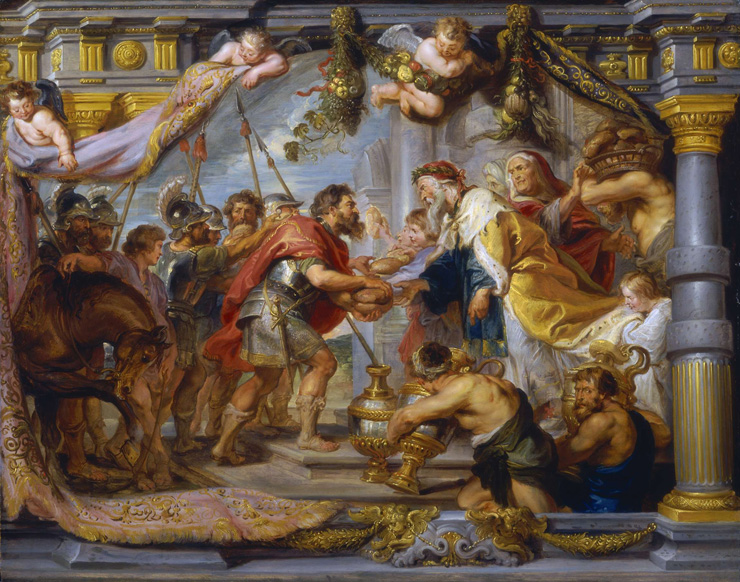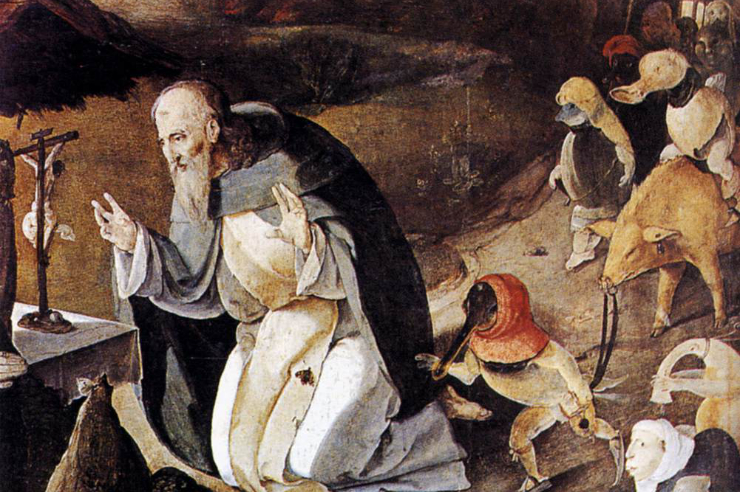Perhaps the most mysterious, enigmatic and intriguing figure in all of the Old Testament is Melchizedek the Canaanite priest who makes a brief appearance in the Old Testament in Genesis. He is also mentioned in the Book of Psalms and is referred to eight times in the New Testament Letter to the Hebrews. Speculation, conjecture, and sometimes just pure wild guessing is set forth to explain exactly who this cryptic figure was.
Some of the Ancient Jews used to think he was the original man, the archetype of Adam. Many Gnostics and New Agers hastily speculate that the priest was some kind of wizard or a mythical savior. Some venture that he was Christ himself. Whoever he was exactly remains somewhat of a mystery even to us today, but what he did and what he stands for shines as clearly for us as the star of the Magi. Melchizedek turns our gaze towards the salvific events precipitated by the Blessed Advent in Bethlehem and fulfilled by the events encompassed by the life death and resurrection of Jesus Christ.
Perhaps the most intriguing assertion put forward by the early Church concerning the identity of Melchizedek is that he may have been Noah’s good son Shem. His very name means the “naming” and to this day we see that Shem is the root word of the label “Semitic” we use to name or describe the descendants of the Jews. While Noah cursed Ham for his shameful deeds, Noah blessed Shem in Genesis 26:9 “Blessed be the LORD, the God of Shem!”Shem is a forefather of the genealogical branch leading to King David and to Christ the King, Our Lord.
The name Melchizedek means “my king is righteousness” and he hailed from Salem, the city whose name signifies “peace.” The city of Salem later became Jerusalem, one of the oldest cities in the world and of great significance throughout the entirety of Salvation History. Melchizedek was a righteous priest of the God Most High. His offering of bread and wine to Abraham and Abraham’s tithe to him form the foundation for the very new and everlasting covenant upon which the eternal disposition of our immortal souls depends.
In Genesis 14 we are introduced to the great priest, who was not a member of the Chosen People. There was a war between several ancient kingdoms in Mesopotamia and Canaan. Abraham’s nephew Lot, his family, and all their material possessions were captured and taken off as war booty. Abraham heard the news, armed 318 of his servants and went on a successful rescue mission. Abraham was victorious by the grace of God and was able to return Lot and his family to their original Canaanite cities. Melchizedek appears when Abraham returned home victorious. Here is what we learn in Genesis 14:18-20:
“And Melchiz′edek king of Salem brought out bread and wine; he was priest of God Most High. And he blessed him and said,
‘Blessed be Abram by God Most High,
maker of heaven and earth;
and blessed be God Most High,
who has delivered your enemies into your hand!’And Abram gave him a tenth of everything.”
It was customary in those days for priests to offer the sacrifices of the “first fruits” such as bread and wine to the Creator of those gifts. It was not coincidental that these gifts foreshadowed Christ sacrifice of His Body and Blood at the Last Supper. It turns out that Melchizedek is emblematic of the prophet, king and priest whose ultimate expression is Christ Himself reiterated by the Gospels in the Sacred Scriptures.
It is significant that Melchizedek, not being a priest of the Chosen People, but still of the “God most high,” was a representative for all nations, prefiguring the notion that God’s salvation is for all peoples, not just the Jews. Melchizedek appears and disappears from the Genesis narrative without genealogical ties showing that his priesthood was not hereditary like that of the Levites, but by divine decree, as a prefiguring for the priesthood of Christ.
The next mention of Melchizedek in the Old Testament is by the author of Psalms in 110:4. We read: “The Lord has sworn, and he will not repent: You are a priest forever, according to the order of Melchizedek.” This is one of the Messianic Psalms foreshadowing the coming of our Lord and Savior Jesus Christ as the priest of priests. The Gospels confirm the accuracy of this bold Messianic prediction as we learn about Christ’s priesthood throughout the New Testament.
The final mentions of Melchizedek are delivered to us by St. Paul in his letter to the Hebrews. In 5:9-10 we learn further of the divine ordination to the eternal priestly order to which Christ Himself was appointed; “and being made perfect he became the source of eternal salvation to all who obey him, being designated by God a high priest after the order of Melchiz′edek.” As opposed to the hereditary order of priests of the tribe of Levi, Christ, the perfect priest after the order of Melchizedek, is the order into which all Catholic priests are ordained today. In Hebrews 7:3, St. Paul further explains Melchizedek’s significance as a type of Christ: “without father or mother, without genealogy, without beginning of days or end of life, resembling the Son of God, he remains a priest forever.” Melchizedek is very mysterious even to St. Paul when it comes to answering historical questions, but perfectly clear about his role in Salvation History.
St. Paul goes on to explain the need for the order of Melchizedek over the Levite priesthood in Hebrews 7:11-12. “If perfection could have been attained through the Levitical priesthood—and indeed the law given to the people established that priesthood—why was there still need for another priest to come, one in the order of Melchizedek, not in the order of Aaron? For when the priesthood is changed, the law must be changed also.” Melchizedek in the Book of Genesis prefigured, not just Christ, but the new covenant and the New Law even long before Aaron and Levi were born.
We may never know for sure the true identity of Melchizedek this side of heaven, but there are more important considerations concerning this mysterious and holy priest in relationship to Jesus Christ. In the Catechism 1544 we learn that “everything that the priesthood of the Old Covenant prefigured finds its fulfillment in Christ Jesus, the one mediator between God and men. The Christian tradition considers Melchizedek, priest of God Most High, as a prefiguration of the priesthood of Christ, the unique high priest after the order of Melchizedek, holy, blameless, unstained, by a single offering he has perfected for all time those who are sanctified, that is, by the unique sacrifice of the cross.”
And of further consequence, we learn from paragraph 1333 about the deep significance of Melchizedek’s offering in being reminded that “at the heart of the Eucharistic celebration are the bread and wine that, by the words of Christ and the invocation of the Holy Spirit, become Christ’s Body and Blood. Faithful to the Lord’s command the Church continues to do, in his memory and until his glorious return… The signs of bread and wine become, in a way surpassing understanding, the Body and Blood of Christ; they continue also to signify the goodness of creation.” We honor to this day that very image of the priest king Melchizedek as the prefiguring of the sacrifice and the new and everlasting covenant.
Melchizedek stands as a herald of the New Covenant foreshadowing the coming perfect sacrifice of Christ and the gift of His Body and Blood. His historical placement deep in the Old Testament is a wondrous sign of God’s perfect, providential and holy plan in weaving the tapestry of Salvation History. The offering of the bread and wine to Abraham anticipates Christ’s institution of the Eucharist at the Last Supper. We do this in memory of Him and we are reminded of God’s timelessness when we consider the pagan priest Melchizedek of the Most High God, that King of Peace prefiguring our Lord and Savior Jesus Christ.
If you liked this article, please share it with your friends and family using the Recommend and Social Media buttons below and via email. We value your comments and encourage you to leave your thoughts below. Thank you! – The Editors














